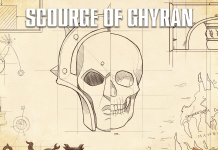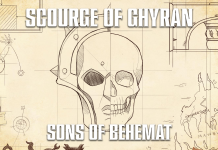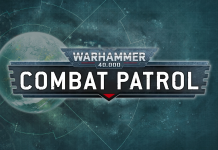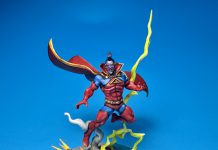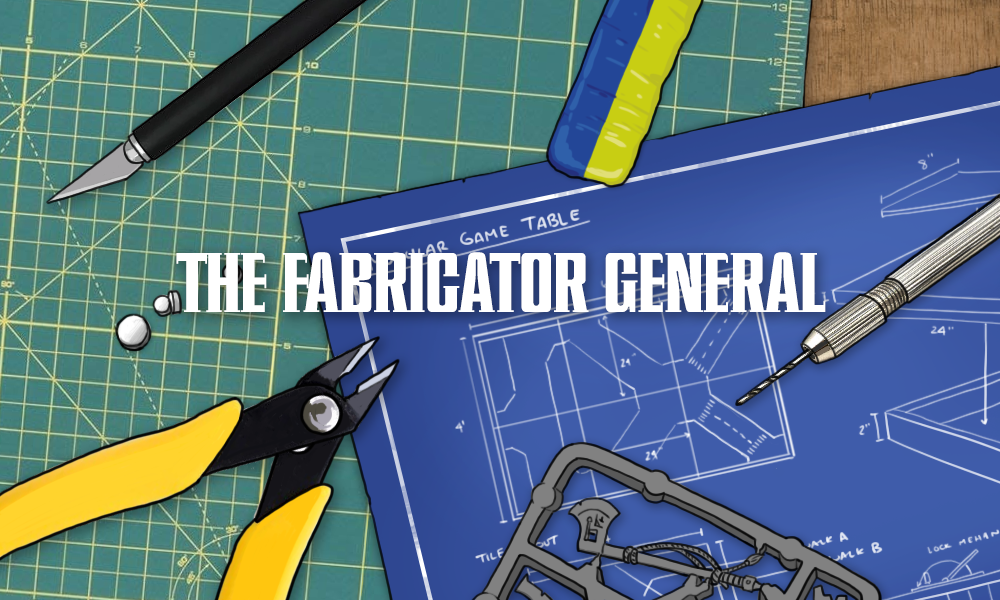In our Fabricator General series, we cover large projects or those with lots of building and construction and custom work. This week, we’re covering how to plan, build, and stock a good workspace for your hobby needs.
I really do believe that the biggest thing you can do to make yourself more productive in painting is to have a dedicated painting space that is comfortable and functional. A dedicated painting space is going to reduce set-up time, reduce spillage and lost items, and allow you to paint for longer periods without discomfort.
I’ve probably had two or three painting areas of varying quality and gone a total of about six or seven years without a dedicated space and productivity was always better when I had a space. The goal of this article is to give you a better idea of what to prioritize and how to get a solid setup without dipping too much into the juice budget. I will also briefly touch on the products I purchased that I consider a good or bad value.
DISCLAIMER: My setup is super swanky right now, and the perfect is the enemy of the good. I live in the blighted Midwest where they give away square footage with happy meals and I paint like 5 models a month -optimistically- so my budget goes into hobby supplies. Never let your setup be a reason to put off putting in the work. The biggest thing is not being a painting nomad, everything else is gravy.
What A Good Workspace Needs
I have organized the elements of a good workspace in order from most to least important.
Painting handles…

… don’t pay me yet. GW: give me money. I’ll say they’re more important than hands for less than you’d think. As things stand now they are neat for the price and some folks really like them, but I rarely bother. If my opinion on this ever changes it will be because I saw reason and they are, in fact, better than Jesus.
Raf: Using painting handles after years of holding the model takes some getting used to, but I will say that once you’re use to it it’s pretty great. I’ve been using old pill bottles for years and having an entire squad mounted on these makes some organizational improvements that – like many things on this list – go a long way to helping make you more efficient.
TheChirurgeon: I am slowly starting to use painting handles now for all my work. It took me a little time to get used to them but now I’m much more comfortable. I don’t have entire squads mounted, but having a few in place is helpful and makes it easy to swap between projects while I wait for something to dry. I will say that in today’s era of everything in plastic, these are a lot less necessary than they used to be; I’d have killed to have them back when I was working with nothing but metal models and paint would rub off from fingers touching them all the damn time. Nowadays it’s not so dire, but it’s still good to avoid doing that where possible.
1. Light
Nothing is more important than a good light source. The holy grail is a large window behind your painting station. I had this for a couple years in college and it was everything you’d want it to be and more. This is not particularly realistic, though. Almost all of us are going to be using light fixtures.
My (hypocritical) opinion is that this should be where you blow your money if you have it. There are three things you should look for in a good light setup:
You want neutral to cool light, because yellow light washes your model out. I used to use a regular incandescent and I thought I had a smooth basecoat on a Razorback I was working on. I brought it into work to finish some edge highlighting and the work fluorescent showed that the tan on the model was so blotchy it looked like a camo pattern. People who are smarter than me say the ideal range is between 5000 and 6000 kelvin.


In the first photos I have normal lights in the 1-2k kelvin range, the second set are with 5-6k range bulbs.
You also want a light you can position. Your angle of sight will change over time and you will naturally want to turn and reposition what you are working on as you work. My favorite sort of light is basically the Pixar logo, having three axis of movement is ideal, some lights even have a clamp to mount to your desk, which not only means you don’t need to worry about knocking it over, but you can also position it however you like without worrying about it being off balance. I like my light over my shoulders, a fixed light is almost inevitably going to end up behind your model at some point, which is functionally worse than just having ambient light.

First photo is with a well positioned light and second is with a light that is not directed well:
Finally, you want redundancy. Models create natural shadow on their own even without other factors, and having one spotlight source is going basically blind you to anything that isn’t in direct light. Then there’s your hands, the brush, the shadow from your head, etc etc etc. I consider two spaced out light sources the minimum, ideally an overhead light in addition to these two spotlights would be perfect. The last advantage to redundancy is there’s nothing stopping you from just turning off other sources if you want an idea of what your model will look like with a singular light source, you can use this as a reference and them continue painting with uniform light once you are comfortable with knowing where light and shadow should be on the figure.

The best thing about lighting is that there is a really affordable item that tics all the boxes. I love this guy right here: https://www.ikea.com/us/en/p/tertial-work-lamp-with-led-bulb-dark-gray-00424985/ If you have the space for the arm to be functional I don’t really see the point in getting anything else. It’s easily positioned, has a clamp, is cheap and durable. I even use the metal arm as a storage area for my magnets since it’s out of the way. If you can buy it without the bulbs that’s ideal. You want to find an e-26 13 watt bulb with 5000-6000 kelvin, which are available on amazon but generally tend to be sold in bulk. The bulb should run for 2-5$ and last for years. This means you can have a really solid light set up for less than $30.
Raf: I recently upgraded my lighting set up with one of those multi-axis clamp lights. It was a gift, but I think this particular light can be had on Amazon for about $60. The little white Ott light is all I had before and this big light is a massive, massive upgrade. It flood the area with nice bright light and I can still use the little one as an additional source. I haven’t actually used the magnifying glass yet, we’ll see how helpful that is.

TheChirurgeon: Light is so incredibly important. I’m lucky to have my desk next to a window, but even then I use a lamp similar to Raf’s for my work. I use one of these: https://www.amazon.com/dp/B0009VU81Q, which is about 5k – 5500 Kelvin in temp and I find gives me much better lighting than a single bulb. I rarely use the magnifying glass; it’s useful for some very specific stuff but it’s very disorienting to work through and I haven’t done it enough to get the hang of it, so I just don’t do it.
2. Space
Cramped conditions are a good way to spill paint, jar your brush and cause frustration. Now, as long as your stuff is in reach I don’t think there’s such a thing as too much space. Limitations obviously exist, but I think there’s an achievable minimum that most folks can manage.
Your natural painting position is most likely with your elbows down on your desk at shoulder width and your hands together. At a minimum I would want enough room to not have anything within 6 inches of your arms in this pose. Ideally you should be clear behind your elbows as well, so you don’t knock anything. I feel like anything less than this is frustrating. My minimum work area is probably about 24 inches long by 18 deep. I generally put some weight on my elbows while I paint so a surface that will take weight without wobbling is also ideal.
The best way to comfortably minimize the needed space is to have your work area separate and defined as different than storage. Larger projects obviously will require more space. I don’t really mind clutter as a general rule, but I have found not keeping my work area separate from storage slows me down and frustrates me. Some people obviously feel differently (hi, Kevin), but I would highly recommend at least trying a workspace with only what you are currently using for a couple weeks and see how you like it.

TheChirurgeon: Living in an urban area, I’m not so blessed with space. But what I try to do is keep a setup where the paints and items I use most often are readily accessible. You can cut down on the desk sprawl by keeping the paints you need for a particular project handy and storing the rest, and making sure that things continually go back in the same space over and over. This reduces the amount of time it will take you to find things and speeds up your hobby progress.
3. Storage
Having an established area for both your tools and for unfinished models/sprues is essential for me. In addition to knowing where your shit is at, having a drawer for work in progress also helps minimize dust and acts of catte. Storage to me is the most underrated part of a good workspace.

Anything not actively being worked on goes in the W.I.P. drawer.
Paint and brushes should be where you look for them consistently. I love my rack (mine is by broken token but any M.D.F. rack will work) and I’ve seen other folks stack pots vertically in various contraptions. The reason I like my solution is it also allows for convenient storage for brushes and other equipment. I keep less commonly used items in a drawer, but that’s personal preference.

Beer tastings are an excellent source for little glass cups. These are great for storing miscellaneous tools. Yes, go to beer tastings so you can get these little glass cups.

I feel like drawers with removable shelves and drawers with fixed drawers are both great for different purposes. The advantage of removable drawers is that you can carry some stuff when you’re displaced. I use a drawer to carry my stuff when I’m dog sitting or something like that.

I threw a bunch of stuff I would typically bring with me if I’m out a long weekend together as an example. My wife was hospitalized recently (she’s fine now) and it was the difference in like 30 hours of painting.
Ikea Detolf is the truth for painted models. Dust sucks, people breaking shit is worse. We already covered a few things around display cases (including modifying Detolfs to have more shelves) in a previous article.

Ikea also sells modular tables which are perfect for our thing. I use this setup: https://www.ikea.com/us/en/p/linnmon-alex-table-white-s49047119/
And I really have no complaints. Ikea also doesn’t pay me (yet), but for some reason a ton of their stuff seems almost purpose built for our thing. I’m sure you can find something similar at a consignment shop.
Raf: Effective storage can also increase your effective workspace. You can see in the image of my lighting setup that I’ve taken advantage of the Citadel paint racks’s ability to mount to the wall. This frees up horizontal space on my relatively small painting desk. By using keyhole mounts I can also take the racks off the wall and transport them as needed in the same way I organize them.
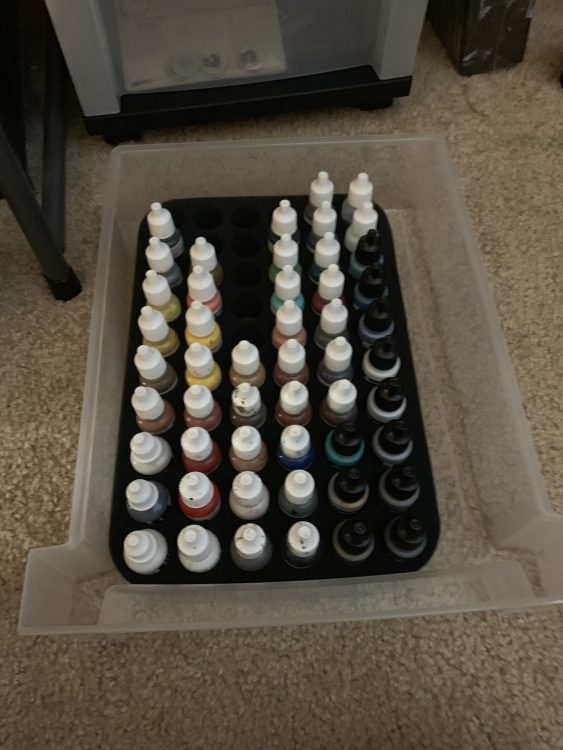
My dropper bottles are stored in the top drawer of a cheap plastic filing cabinet I got on Amazon. Along with that, I ordered a paint carrying case that came with a removable foam insert. The insert now lives in the filing cabinet and organizes all my droppers. Again, this frees up horizontal space as I can simply leave the cabinet under the table and grab paints out of the drawer as needed.
4. A Water Solution
When some people hear “never again” they think of Pearl Harbor or the Armenian Genocide or how they systematically alienated all their relatives. When I hear it I think of that time I got metal flakes where I didn’t want them on a model. Getting up to change your water sucks and is totally avoidable for basically no money. I think a good water setup has 3 parts:

A good, solid and heavy water bowl. You will knock a light plastic cup over. I’d grab anything you can get away with that is ceramic and holds at least half a cup of water. Dump it whenever you use any metallics and whenever it gets close to opaque. Total volume is a personal preference, I prefer it smaller as I dump frequently and don’t like wasting water. I’ll rinse it with a little clean water and wipe it with a hand towel to avoid any remaining pigment/flakes.
A container for clean water.
A dumping bowl. This guy is about 12” diameter and ~4” deep and will last me at least 8-10 hours of painting. Get some take out and only have to venture to a sink every week or so.
I can’t stress how convenient it is to know that I don’t need to get up every time I want to change water. This is basically free and is a massive quality of life improvement. I’d rate these three random articles of trash some of the most important tools I have.
TheChirurgeon: I use the Citadel water pots for this and they’re quite good. They’re wider on the bottom and it makes them very difficult to tip over or spill. Also a well set-up, spacious desk helps reduce spills as well. My sink isn’t that far from my desk so dumping bowls aren’t that big an ask for me and I don’t have the space for one. Also NOTE FOR CAT OWNERS: If you haven’t noticed already, your cat WILL drink from your paint water bowls when you aren’t looking. Most of the paints we use (including Citadel) are non-toxic, but it’s still not a good idea to let them drink the paint water. Keep your bowl/cup dry or covered when it’s not in use.
5. A Palette
Wet palette vs dry palate is a debate that I recognize as existing –
even though it shouldn’t, wet palate forever. We already wrote about how you can make your own wet palette pretty cheaply in a previous article.

If you are a terrible person who likes using a dry palette I can pretend to relate; I have certain metallics I use that don’t cooperate on a wet palate.
That said, you are never going to improve as a painter beyond a certain point if you paint out of the pot. Painting out of the pot means you can’t control how watered down the paint is, you run a stronger risk of ruining your brush by getting paint into the ferrule, and you will inherently waste paint. A dedicated palette also allows you to blend without contaminating your pots.
I have used wet palettes for 8+ years, so at this point I only really have opinions on them. It costs almost nothing to make an ersatz palette, you just need Tupperware, baker’s paper and paper towels. There’s nothing wrong with the functionality as long as you replace the paper towels and the initial investment is so low I think everyone should try it for a bit at least.

I do think that it’s worth upgrading to a commercial wet palette if you like them, I bought the Redgrass (https://www.redgrassgames.com/) one and would tentatively recommend it. It does NOT keep paint indefinitely like they claim, however the foam they use is really consistent and never molds, and the paper they use is great. I consider it overpriced, but it is a solid product. I’d like to know how folks like the Army Painter version, which is like half the price and looks to be more or less a straight copy.
6. Brush soap

Absolutely mandatory. I like The Masters, you can get it at Michael’s and it’s in a tan jar. I have not done any comparison shopping. One puck will last you years. You should not invest in brushes until you have this.
TheChirurgeon: Fine. I’ll go buy some brush soap, I guess.
Summary
So to wrap things up, what you’ll notice when you look at my setup is that I spent more money than I had to, but it checks the most important boxes and you could easily get something similar while scrimping. Join me next time when I critique my own set up as well as a few other volunteers who wanted to share their spaces. It will be done when it’s done.
Raf: I don’t know who needs to hear this, but you have enough models. I’m only half joking but the uncomfortable truth for most of us is that we probably have enough grey plastic floating around to last us a couple of years. If you’re like me, you’re probably loathe to spend hobby budget on anything but models but it can be worth it to invest a little in your hobby station. You’ll paint more faster and make the construction/painting part of this hobby even more enjoyable.
TheChirurgeon: Couldn’t agree more. The lure of new plastic will always be there. Invest in the equipment and materials you’ll need to turn that plastic into the jewel-like objects of wonder they can be.
Got any questions or feedback? Drop us a note in the comments below or email us at contact@goonhammer.com.


